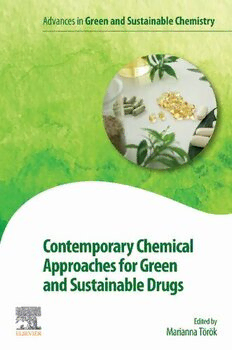
Contemporary Chemical Approaches for Green and Sustainable Drugs PDF
Preview Contemporary Chemical Approaches for Green and Sustainable Drugs
Contemporary Chemical Approaches for Green and Sustainable Drugs Advances in Green and Sustainable Chemistry Contemporary Chemical Approaches for Green and Sustainable Drugs Series Editor Be´la To¨ro¨k Timothy Dransfield Edited by Marianna To¨ro¨k Elsevier Radarweg29,POBox211,1000AEAmsterdam,Netherlands TheBoulevard,LangfordLane,Kidlington,OxfordOX51GB,UnitedKingdom 50HampshireStreet,5thFloor,Cambridge,MA02139,UnitedStates Copyright(cid:1)2022ElsevierInc.Allrightsreserved. Nopartofthispublicationmaybereproducedortransmittedinanyformorbyanymeans, electronicormechanical,includingphotocopying,recording,oranyinformationstorage andretrievalsystem,withoutpermissioninwritingfromthepublisher.Detailsonhowto seekpermission,furtherinformationaboutthePublisher’spermissionspoliciesandour arrangementswithorganizationssuchastheCopyrightClearanceCenterandtheCopyright LicensingAgency,canbefoundatourwebsite:www.elsevier.com/permissions. Thisbookandtheindividualcontributionscontainedinitareprotectedundercopyrightby thePublisher(otherthanasmaybenotedherein). Notices Knowledgeandbestpracticeinthisfieldareconstantlychanging.Asnewresearchand experiencebroadenourunderstanding,changesinresearchmethods,professional practices,ormedicaltreatmentmaybecomenecessary. Practitionersandresearchersmustalwaysrelyontheirownexperienceandknowledgein evaluatingandusinganyinformation,methods,compounds,orexperimentsdescribed herein.Inusingsuchinformationormethodstheyshouldbemindfuloftheirownsafety andthesafetyofothers,includingpartiesforwhomtheyhaveaprofessionalresponsibility. Tothefullestextentofthelaw,neitherthePublishernortheauthors,contributors,or editors,assumeanyliabilityforanyinjuryand/ordamagetopersonsorpropertyasamatter ofproductsliability,negligenceorotherwise,orfromanyuseoroperationofanymethods, products,instructions,orideascontainedinthematerialherein. ISBN:978-0-12-822248-5 ForinformationonallElsevierpublicationsvisitourwebsiteat https://www.elsevier.com/books-and-journals Publisher:SusanDennis AcquisitionsEditor:GabrielaCapille EditorialProjectManager:ClarkEspinosa ProductionProjectManager:SujathaThirugnanaSambandam CoverDesigner:MarkRogers TypesetbyTNQTechnologies Contents List ofcontributors xiii 1. Using the zebrafish model system to identify the health effects of pharmaceutical pollutants Christina Kaucic,AnushaLakshmiDharmavathi andJenniferL.Freeman 1. Introduction 1 2. Thezebrafishmodelsystem 2 3. Useofthezebrafishmodelsystemindrugdiscovery 3 4. Significanceofpharmaceuticalpollution 6 5. Useofthezebrafishmodelsystemtoassesspharmaceutical pollutanttoxicity 7 6. Methodsandapproaches toassesspharmaceuticalpollutant toxicityusingthezebrafishmodelsystem 13 6.1 Acutedevelopmentaltoxicityassessmentswiththe developingzebrafish 13 6.2 High-throughputscreenings(HTS)fordevelopmentaltoxicity assessments 14 6.3 Zebrafishdevelopmentalandadultbehavioralassaystoassess pharmaceuticalpollutant toxicity 16 6.4 Cellularandmolecularassaystoidentifymechanismsof pharmaceuticalpollutant toxicity 18 7. Futuredirectionsfor theuseofzebrafishindefining pharmaceuticalpollutanttoxicity 20 8. Conclusions 21 AcknowledgmentsandFundingsources 21 References 21 2. Analysis of pharmaceuticals in the environment Aditya KulkarniandScottE.Miller 1. Introduction 27 2. Sourcesofpharmaceuticalpollutants 28 2.1 Effectsoftracelevelpharmaceuticalpollutantson humans 29 2.2 Effectsoftracelevelpharmaceuticalpollutantson aquaticenvironments 30 v vi Contents 3. Analyticalmethods for tracelevelanalysisofwatersamples 32 3.1 Solidphaseextraction(SPE) 33 3.2 High-performanceliquidchromatography(HPLC) 35 3.3 Massspectrometry(MS) 36 3.4 Othertechniques 39 4. Riskmanagement 41 5. Conclusion 41 Listofabbreviations 41 References 42 3. Leaking of antibiotics in the aquatic environment Indu,ManishaSharmaandKashyapKumar Dubey 1. Introduction 47 2. Howantibioticsarereaching theaquaticenvironment? 49 2.1 Fromhumanuse 49 2.2 Fromhospitalwaste 53 2.3 Fromanimaluse 56 2.4 Fromagriculturaluse 58 2.5 Frompharmaceuticalindustrywaste 59 3. Fateofantibioticsinaquatic environment 60 4. Conclusion 61 References 62 4. Advances in drug development with the application of artificial intelligence ManuelaSouzaLeite,AndersonAllesdeJesus, PauloJardelLeiteAraujoandBrunnoFerreiradosSantos 1. Machinelearningandartificialintelligence inthe pharmaceuticalindustry:perspective 69 2. Datamining techniques 71 2.1 Statistics 72 2.2 Clustering 72 2.3 View 72 2.4 Decisiontree 73 2.5 Neuralnetworks 73 3. Artificialneural networks(ANN)inpropertyprediction todrugdiscovery 75 4. Supportvectormachines(SVM)indrugdiscoveryand development 78 5. Conclusion 80 Listofabbreviations 81 Acknowledgments 81 References 81 Further reading 88 Contents vii 5. Virtual screening techniques in pharmaceutical research Justine C. Williams, Stanley Opare, Senthil Kumar Sugadoss, AravindhanGanesanandSubhaKalyaanamoorthy 1. Introduction 89 2. Structure-based drugdesign(SBDD) 91 2.1 Proteinstructureprediction 92 3. Moleculardocking 96 3.1 Searchalgorithms 96 3.2 Scoringfunctions 97 3.3 Targetflexibility 101 3.4 Denovodrugdesign 101 3.5 Binding energyestimation 103 3.6 Machine/deeplearningmethodsinSBVS 104 4. Ligand-based drugdiscovery (LBDD) 107 4.1 Similarity searching 108 4.2 Ligand-basedpharmacophoremapping 113 4.3 Quantitativestructure-activity relationship(QSAR) modeling 115 5. Summaryandperspectives 117 References 119 6. In silico modeling of environmental toxicity of drugs KabiruddinKhanandKunal Roy 1. Introduction 129 2. Pharmaceuticalecotoxicityanalysis: generalconsiderations 129 2.1 Overviewofconcerns 130 3. Releaseofpharmaceuticalstotheenvironment 131 3.1 Thesourcesofpharmaceuticals pollutiontoenvironment 131 4. Assessment ofecotoxicityofAPIs,limitations,andsolutions: a datascientist’sperspective 131 5. Current advancement inecotoxicitymodeling of pharmaceuticals 132 5.1 Insilicotoolsreportedindifferentresearcharticles 133 6. Online expertsystemsforecotoxicity prediction 141 7. Conclusion 149 Nomenclaturelist 150 Acknowledgments 151 References 151 viii Contents 7. Sustainable separations in pharmaceutical manufacturing GergoIgnacz,RobertOrkenyi,ArpadKonczolandGyorgySzekely 1. Introduction 155 1.1 Separationconceptsinthepharmaceuticalindustry 156 1.2 Continuous andautomatedseparationprocesses 158 2. Chromatography-basedseparations 159 2.1 Sustainableaspectsofchromatography 159 2.2 Towardgreenchromatographictechniques 159 2.3 Strategiestoward greenliquidchromatography 162 2.4 Relevantindustrialapplications:casestudies 166 2.5 Conclusions 167 3. Membranebasedseparations 167 3.1 Membraneseparationinthepharmaceuticalindustry: a liquiddominantsector 167 3.2 Organicsolventnanofiltration(OSN) 168 4. Continuouspurificationprocesses 174 4.1 Classification ofthecontinuousflowpurification processes 174 4.2 Continuous crystallization(CC) 175 4.3 Centrifugalpartitionchromatography 177 4.4 Simulated movingbedchromatography 179 4.5 Comparisonofthepreviouslydiscussedcontinuous purificationmethods 180 5. Forecastingthefuture ofAPI separations 183 Listofabbreviations 184 References 185 8. Green synthetic methods in drug discovery and development GuoshuXie,RitaBernadettVlocsko´ andBe´laTo¨ro¨k 1. Introduction 201 2. Catalysis 203 2.1 Homogeneous catalysis 204 2.2 Heterogeneouscatalysis 217 3. Nontraditionalactivationmethodsandenergyefficiencyof chemicalprocesses 238 3.1 Microwave-assisted organicsynthesis 238 3.2 Ultrasonicactivation 242 3.3 Photochemicalactivation 248 3.4 Electrochemicalactivation 256 4. Conclusions 260 References 261 Contents ix 9. Characterizing the environmentally benign nature of chemical processes: green chemistry metrics DavidDaggett,YizhouShi andBe´laTo¨ro¨k 1. Introduction 281 2. Emergence ofgreenchemistry 282 3. Sustainableproductionofpharmaceuticalsandtheirbuilding blocks: quantitativegreenmetrics toevaluatechemical processes 282 3.1 Mass-relatedmetrics 283 3.2 Energy-related metrics 294 3.3 Greenhousegasemissionandozonecreationmetrics 296 3.4 Solvent-relatedmetrics 298 3.5 Life cycleassessment(LCA) 300 4. Conclusions 300 References 301 10. Green chemistry approaches to drugs that treat epidemic and pandemic diseases BerkeleyW.Cue 1. Introduction 307 2. Antibacterial drugs 309 2.1 Penicillinandcephalosporinantibiotics 309 2.2 Macrolideantibiotics 310 2.3 Fluoroquinoloneantibiotics:ciprofloxacin 313 3. Drugs totreatmalaria 313 3.1 Amodaquine 314 3.2 Arteminisin 315 3.3 Hydroxychloroquine 317 3.4 Piperaquine 318 4. Drugs totreatHIV/AIDS 318 4.1 Nevirapine 319 4.2 Dolutegravir 321 5. Antivirals totreatCOVID-19 322 5.1 Remdesivir 322 5.2 Molnupiravir(EIDD-2801,MK-4482) 323 6. Conclusions 325 References 326 Further reading 330 11. Dynamic effects of organic molecules for drug delivery in micelles DebanjanaGhosh,RiaRamoutarandShainazLandge 1. Introduction 333 2. Drugsolubilizationthroughdrugdeliveryvehicles 335 2.1 Micelles 335 2.2 Liposomes 336 x Contents 3. Moleculardrugdeliverybyorganized self-assemblies 337 3.1 Small molecule-surfactantbaseddrugdelivery 337 3.2 Liposomalsystemasdrugdeliveryvehicle 347 3.3 Reversemicellesnanocarriersfordrugdelivery 360 4. Conclusion 370 Listofabbreviations 371 References 373 12. Antibody-drug conjugates for targeted delivery GarimaPandey,SunilK.TripathiandVivekBulbule 1. Introduction 377 1.1 What isanantibody-drugconjugate? 377 1.2 ImportanceofADCs intargeteddrugdelivery 379 1.3 Current ADCsapprovedorinclinicaltrials 380 2. Composition 385 2.1 Targetandantibody 385 2.2 Linkers 386 2.3 Payloads 395 3. Antibody-drugconjugation 396 3.1 Throughsidechainlysineresidue 397 3.2 Throughsidechaincysteineresidue 398 3.3 Drugantibodyratio(DAR) 400 3.4 Site-specific conjugation 400 4. Physicalstabilityofantibody-drug conjugates 403 5. Chemicalstabilityofantibody-drugconjugate 404 6. Formulationdevelopmentofantibody-drug conjugate 405 7. FutureaspectsofADCs 406 Listofabbreviations 407 References 408 13. Toward the green synthesis of peptides and peptidic drugs Do´raBogda´n,LeventeKa´rpa´tiandIstva´nM.Ma´ndity 1. Peptidesandpeptidesynthesis:theformationofpeptide bond 421 1.1 Historicalperspective ofsolutionphasepeptidesynthesis 421 1.2 Solid-phase peptidesynthesis(SPPS) 422 1.3 Solid-phase fragment/segmentcondensationinthe1980s 424 1.4 AutomatizationoftheSPPS 424 2. Improvements inthe solid-phasemethod 426 2.1 Optimization ofthelinkersandpolymericsupportsin SPPS 426 2.2 DevelopmentoftheN-terminalaminoprotecting groups 427 2.3 On resinmonitoring ofthecouplingefficiency 428
